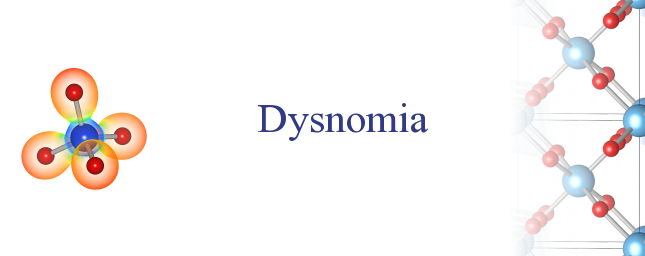Introduction
Dysnomia is a program for calculation of electron and nuclear densities from observed structure factors by means of the maximum entropy method (MEM). It is a successor of a MEM program PRIMA. Both PRIMA and Dysnomia are parts of the VENUS software package.License agreement
Dysnomia LICENSE
Version 1
Copyright (C) 2011-2021, Koichi Momma and Fujio Izumi
Version 1
Copyright (C) 2011-2021, Koichi Momma and Fujio Izumi
Dysnomia is distributed free of charge but currently copyrighted with its source code not open to the public because we wish to control its development and future by ourselves. Permission to use this software is hereby granted under the following conditions:
- Whenever original results acquired with Dysnomia are published in journals, proceedings,
and review articles, the program name "Dysnomia" should explicitly be stated, and the
following article must be quoted:
Only giving credit to Dysnomia is suffice in the cases of abstracts, facility reports, and so
forth with limited spaces, for example, as follows:
Electron-density distributions in CaTiO3 were determined by MPF from the X-ray diffraction data with Dysnomia.
- Dysnomia is provided "as is" without any expressed or implied warranty. We do not provide any technical support for free.
- You should not redistribute any copy of the distributed files unless you have a written permission from us.
If you find a problem or a bug on use of Dysnomia, please let us know and help us improve it.
Download
 Windows
Windows- Dysnomia.zip (ver. 1.0, built on Dec. 8 2018, 14.2MB)
This package includes both 32 bit and 64 bit versions, run on Windows XP or newer.
 macOS
macOS- Dysnomia.dmg (ver. 1.0, built on Dec. 8 2018, 13.8MB)
Requires OS X 10.9 or newer.
 Linux
Linux- Dysnomia-i686.tar.bz2 (ver. 1.0, built on Dec. 8 2018, 4.53MB)
- Dysnomia-x86_64.tar.bz2 (ver. 1.0, built on Dec. 8 2018, 11.1MB)
Examples
- Dysnomia_Examples.zip (3.87MB, Uploaded on Jul. 14 2015)
Manual
- Dysnomia_Manual.pdf (122KB, uploaded on Dec. 2 2014)
References
- K. Momma, T. Ikeda, A. A. Belik and F. Izumi: Dysnomia, a computer program for maximum-entropy method (MEM) analysis and its performance in the MEM-based pattern fitting. Powder Diffr., 28, 184-193, (2013).
- K. Momma and F. Izumi: Evaluation of algorithms and weighting methods for MEM analysis from powder diffraction data, Z. Kristallogr. Proc., 1, 195-200 (2011).
- F. Izumi & K. Momma: Three-dimensional visualization of electron- and nuclear-density distributions in inorganic materials by MEM-based technology. IOP Conf. Ser.: Mater. Sci. Eng., 18, 022001 (2011).
- Dec. 8 2018 ver. 1.0
- Fixed a bug that *.pgrid file generated by Dysnomia had invalid format and could not be visualized by VESTA in the case of space group P1.
- Enabled to run even when data or the program path contain non-ASCII characters
- Updated orthorhombic space group symbols containing symmetry element "e" to comply with the latest standards, e.g., A e m 2 instead of A b m 2. Files with old symbols are still supported.
- Jul. 14 2015 ver. 0.9
- Fixed a bug in the calculation of dS/dF in the output file. This bug did not affect the results of MEM-calculated densities or structure factors, and the bug only existed in the DFT routine or when dealing with data with negative densities.
- When some of input data are invalid, now the program stops with error messages and will not crash silently.
- Improved convergence stability of L-BFGS algorithm in an extreme case.
- Dec. 2 2014 ver. 0.8
- First public release.
- In addition to the ZSPA and Cambridge algorithm, added new L-BFGS algorithm.


